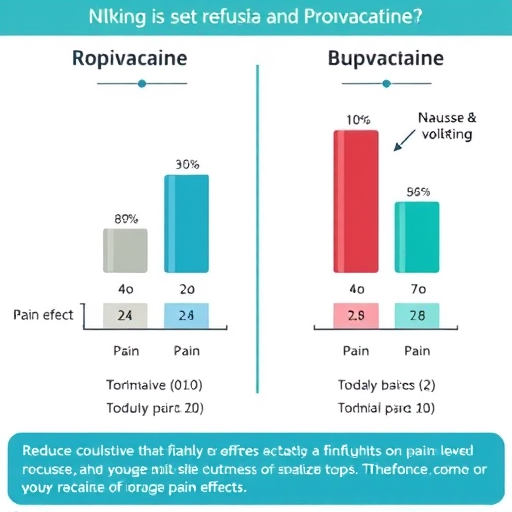Volume 35, Issue 246 (7-2025)
J Mazandaran Univ Med Sci 2025, 35(246): 164-172 |
Back to browse issues page
Download citation:
BibTeX | RIS | EndNote | Medlars | ProCite | Reference Manager | RefWorks
Send citation to:



BibTeX | RIS | EndNote | Medlars | ProCite | Reference Manager | RefWorks
Send citation to:
Eftekharian F, Zahabi F, Rastgarian A, Kalani N, Sahraei R. Comparison of Ropivacaine and Bupivacaine on Analgesia Quality and Incidence of Nausea and Vomiting in Patients Undergoing Nephrolithotripsy with Spinal Anesthesia: A Randomized Double-Blind Clinical Trial. J Mazandaran Univ Med Sci 2025; 35 (246) :164-172
URL: http://jmums.mazums.ac.ir/article-1-21678-en.html
URL: http://jmums.mazums.ac.ir/article-1-21678-en.html
Abstract: (134 Views)
Background and purpose: Nowadays, intraspinal anesthesia is widely used as the method of choice for many nephrolithotripsy surgeries. Postoperative pain management remains one of the primary concerns for anesthesiologists. The aim of this study was to compare the effects of ropivacaine and bupivacaine on the degree of analgesia, as well as the incidence of postoperative nausea and vomiting, in patients undergoing nephrolithotripsy surgery with spinal anesthesia.
Materials and methods: This study was designed as a randomized, double-blind clinical trial. A total of 93 patients scheduled for nephrolithotripsy surgery and classified as ASA physical status I or II were included. Patients were randomly assigned to one of two groups: bupivacaine or ropivacaine. The data collection tool consisted of a checklist that recorded information on age, gender, incidence of nausea, sensory block level, and quality of analgesia. Data analysis was performed using SPSS version 21. Both descriptive statistics (frequency, mean, and standard deviation) and inferential analysis (Chi-square test) were used. A significance level of P < 0.05 was considered statistically significant.
Results: The results of the present study showed that the bupivacaine and ropivacaine groups were comparable in terms of demographic characteristics, including age, gender, and ASA physical status. The results of the Chi-square test indicated a significant difference between the two groups in terms of sensory block level (P= 0.020), which was higher in the ropivacaine group. There was no statistically significant difference between the groups regarding the quality of analgesia (P= 0.075). However, a significant difference was observed in the incidence of nausea and vomiting (P= 0.008), with a higher prevalence in the bupivacaine group.
Conclusion: The results of the present study indicate that both ropivacaine and bupivacaine provide effective postoperative analgesia in patients undergoing nephrolithotripsy surgery. However, the incidence of side effects, particularly nausea and vomiting, was higher in the bupivacaine group compared to the ropivacaine group.
(Clinical Trials Registry Number: IRCT20130926014779N5)
Materials and methods: This study was designed as a randomized, double-blind clinical trial. A total of 93 patients scheduled for nephrolithotripsy surgery and classified as ASA physical status I or II were included. Patients were randomly assigned to one of two groups: bupivacaine or ropivacaine. The data collection tool consisted of a checklist that recorded information on age, gender, incidence of nausea, sensory block level, and quality of analgesia. Data analysis was performed using SPSS version 21. Both descriptive statistics (frequency, mean, and standard deviation) and inferential analysis (Chi-square test) were used. A significance level of P < 0.05 was considered statistically significant.
Results: The results of the present study showed that the bupivacaine and ropivacaine groups were comparable in terms of demographic characteristics, including age, gender, and ASA physical status. The results of the Chi-square test indicated a significant difference between the two groups in terms of sensory block level (P= 0.020), which was higher in the ropivacaine group. There was no statistically significant difference between the groups regarding the quality of analgesia (P= 0.075). However, a significant difference was observed in the incidence of nausea and vomiting (P= 0.008), with a higher prevalence in the bupivacaine group.
Conclusion: The results of the present study indicate that both ropivacaine and bupivacaine provide effective postoperative analgesia in patients undergoing nephrolithotripsy surgery. However, the incidence of side effects, particularly nausea and vomiting, was higher in the bupivacaine group compared to the ropivacaine group.
(Clinical Trials Registry Number: IRCT20130926014779N5)
Type of Study: Brief Report |
Subject:
anesthesia
Send email to the article author
| Rights and permissions | |
 |
This work is licensed under a Creative Commons Attribution-NonCommercial 4.0 International License. |







